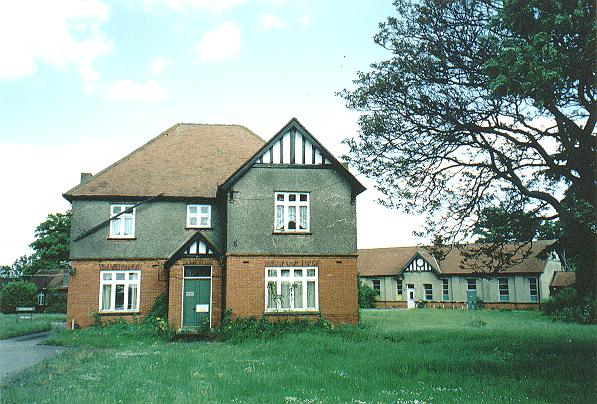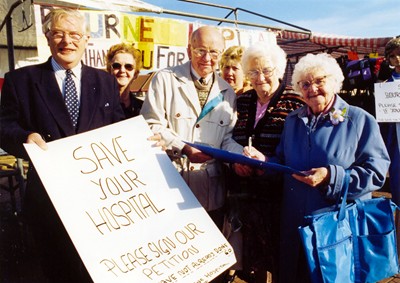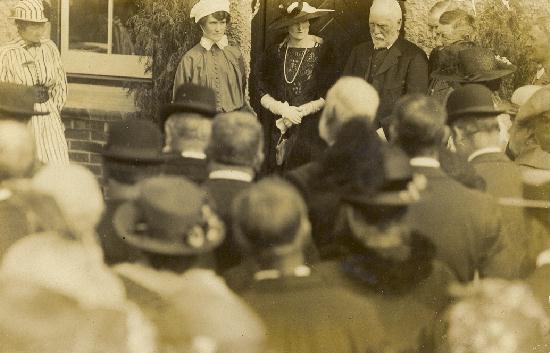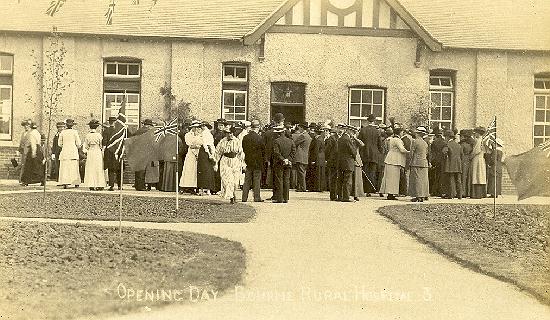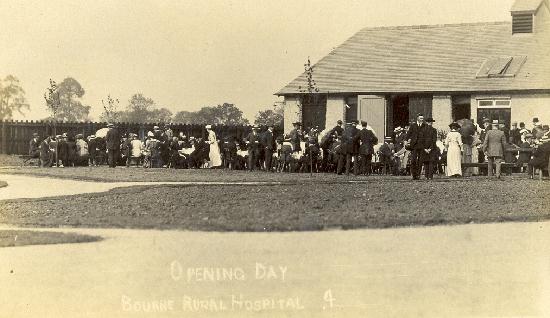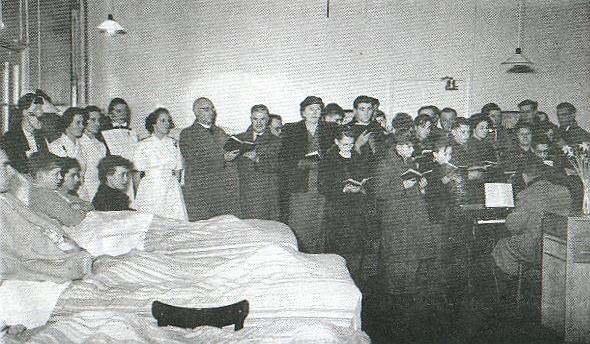|
Bourne Hospital
Bourne once had three permanent hospitals but all have closed although two of the buildings are now being used for different purposes. The other is Bourne Hospital in South Road, the biggest in the town that was shut despite a vigorous protest campaign by local people to save it. They raised a petition containing 8,000 names to keep it open but the battle was eventually lost in September 1998 and the premises were left standing empty for the next five years before being demolished.
The hospital started life in the early part of the 20th century when it was built at a cost of £5,000 [£422,000 at today's values] by Bourne Rural District Council as an isolation unit for patients with infectious diseases which were prevalent at the time, hence its location a mile outside town. Building was completed in 1915 and the Countess of Ancaster performed the official opening ceremony on June 2nd. The plans were drawn up by the council's own surveyor and architect, Mr Thomas Lake, and construction work was carried out by the contractors Messrs Thornhill Brothers of Lincoln. The complex included a lodge keeper's house at the entrance gate, a house for the matron and nurses in the centre of the grounds, a storeroom and administrative department and the fever section behind, consisting of two large wards, male and female, each with six beds including two for children. To the north was another group of buildings containing four observation wards intended for use by patients whose symptoms had not developed sufficiently for doctors to ascertain their condition, or for the reception of private patients. At the extreme east of the site were the mortuary, an ambulance shed, laundry, disinfector and a gas plant while water was supplied from a borehole that had been sunk to an artesian well on the site and all of the buildings were lit by gas. The gardens surrounding the hospital had been landscaped with flowers, trees and shrubs. It was also proposed to add sanatorium treatment at the hospital in the future and temporary wooden huts would be provided as an interim measure. The Countess said at the ceremony: "The hospital has been built to the most up-to-date methods and I feel sure that anyone who is removed here will have the very best attention and will be able to return to their homes as quickly as possible." She was presented with a gold key by the builders bearing the inscription: "Presented to the Countess of Ancaster by Thornhill Brothers, contractors, Lincoln, on her opening Bourne Rural District Council hospital, 2nd June 1915." Mr E B Binns, chairman of the council's hospital committee, who had been responsible for the project, was also presented with a rose bowl by the council chairman Mr W Hayes inscribed: "Presented to Mr E B Binns by the members and officers of Bourne R D C, June 3rd, 1915."
The council appointed its first full time matron on 8th December 1916. She was Miss Annie Wemyss Galletly who began work four days later at a salary of £50 a year, payable in monthly instalments but she was also provided with furnished accommodation at the hospital together with the free use of gas, water, coal and all of her meals. Her employment contract gives a glimpse of employment conditions at that time because it stipulated that she could not engage in any outside work, that she could take four weeks’ holiday each year by arrangement with the council and that one month’s notice on either side would be required if her employment was terminated. Miss Galletly was also required to keep the hospital’s account and record books which would be available at all times for inspection by council officials or the Local District Auditor. Miss Galletly continued as matron until she resigned in July 1920. The hospital was originally intended for patients suffering from infectious diseases such as scarlet fever, diphtheria and typhoid but from January 1918, cases of tuberculosis were also admitted and it soon became evident that separate accommodation would be more desirous for these patients who were being received from all parts of South Lincolnshire, including Stamford, Spalding and Sleaford. Bourne RDC therefore began a campaign of intensive lobbying for additional funds to build a tuberculosis pavilion within the grounds but it took several years before their objective was achieved. Work finally got underway in 1925, culminating with an official opening on Wednesday 30th December in that year. The building was erected by the council with a capital outlay of £4,500 [£225,000 at today's values], including grants from the Ministry of Health and Kesteven County Council. The contractors were Messrs Bowman and Sons of Stamford and the plans and specifications were again drawn up by Mr Thomas Lake, the council's own surveyor and architect.
The structure was then regarded as one of the finest buildings of its kind in the country, a single storey erection with a south western frontage approximately 50 yards from the main Bourne to Market Deeping road, now the A15. The upper portion of the brickwork was rough cast and the roofing of local red tiles, corresponding with the other buildings in the isolation hospital complex. The pavilion contained four single bed wards and four double bed wards with a recreation room for each sex at either end and quarters for the nurses in the centre. There was also a spacious verandah and the entire building was heated with hot water radiators. The opening ceremony took place amid a storm which made it difficult for the speakers to be heard above the wind and rain. The proceedings were conducted by Mr C H Feneley, chairman of Bourne RDC, supported by the Earl of Ancaster, Sir Charles Welby, chairman of Kesteven County Council, and a large number of councillors and visitors. The dedication ceremony was conducted by the Rev Fisher Taylor, Vicar of Baston, who was also a member of the council. It was through this early co-operation that the present system of health administration for Bourne sprang and although geographically in Lincolnshire, the hospital was taken over in 1949 by the Peterborough Area Health Authority which also controlled the Stamford and Rutland Hospital. While the Bourne Hospital was open, this system operated to the disadvantage of local residents who were often sent for advanced treatment to Peterborough while patients from Peterborough were sent to Bourne. For much of this time, the hospital was still in debt. The £5,000 to build it had been raised on mortgage over a period of 40 years at an interest rate of 3½% and there were other long term bank loans to pay for extensions, £3,370 to help build the tuberculosis pavilion together with £200 from the Grimsthorpe Estates to buy furniture, and a further £3,500 ten years later, debts that were not finally settled until 1949. But throughout, the cost fell on the people of Bourne who were being levied through their rates to fund this hospital for almost half a century. But the hospital continued to provide a valuable and much needed amenity for the town and surrounding area. By 1965, it was being run as a medical and surgical unit with 53 beds, two consultants and a medical officer, a matron, nine day and night nursing staff, four kitchen workers and a porter. There was also a chest X-ray unit which was used by the town and district and a domiciliary nursing service consisting of two sisters trained in midwifery, ante and post natal work, a health visitor and a medical officer of health, attending to around 60 cases a year and making 200 visits each month. The service was also responsible for clinics specialising in the eyes, orthopaedics, remedial and relaxation therapy and child welfare. After closure in 1998, the empty buildings slowly deteriorated and the grounds became overgrown and neglected while the site awaited a buyer, a monument to a National Health Service that was launched in 1948 with such good intentions of providing a first class medical service from cradle to grave but after fifty years began to founder on the rocks of mismanagement, inefficiency, trade union supremacy, over-staffing and a chronic shortage of funds. Early in 2003, the four-acre site was sold to a private developer, Stamford Homes, who planned to build 71 homes on the land and in June that year, bulldozers moved in to demolish the complex which disappeared within a few weeks with no promise that the town would ever again have its own hospital.
REVISED JANUARY 2013 See also The end - a pictorial record Memories of the hospital Go to: Main Index Villages Index |
||||||||||||||
